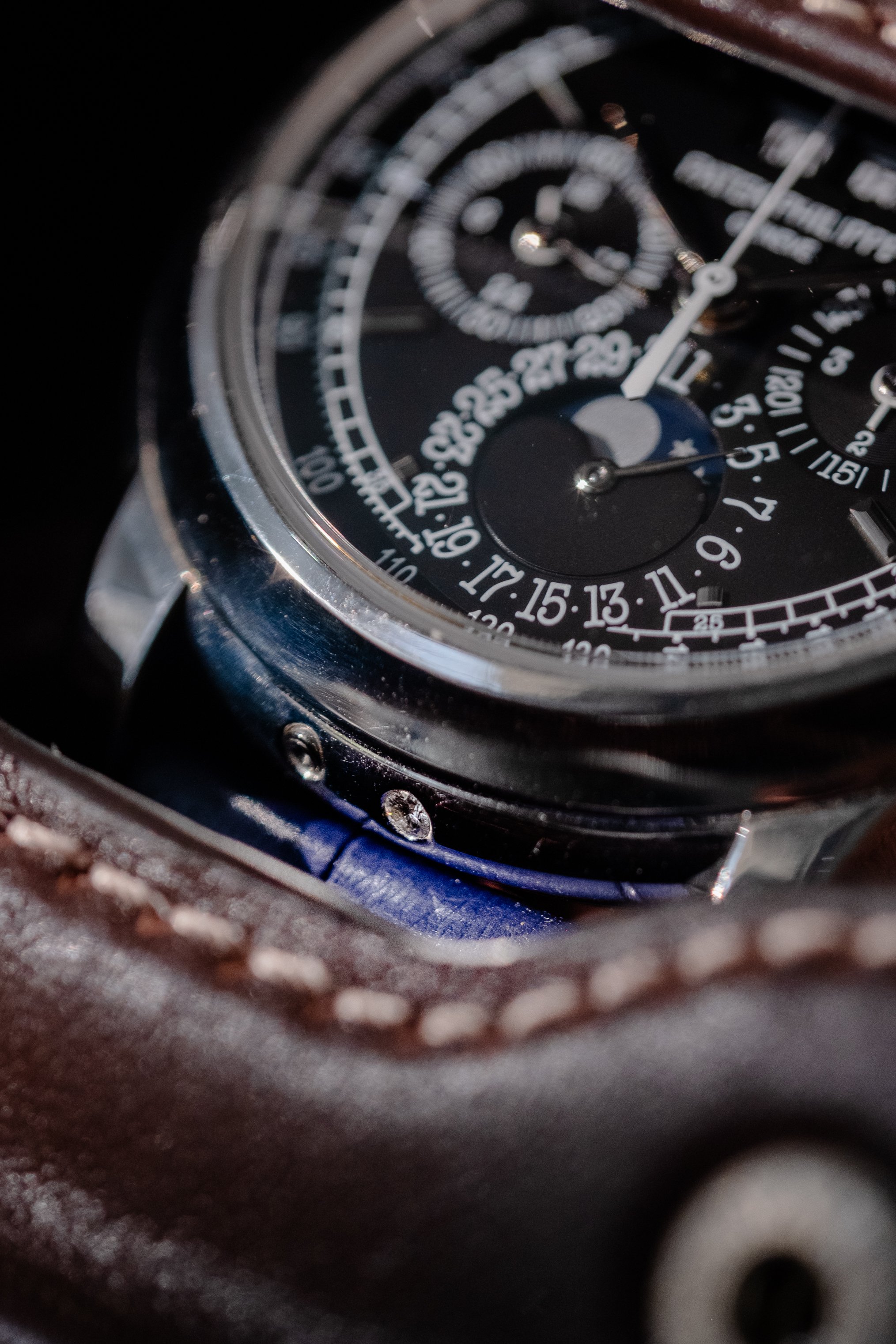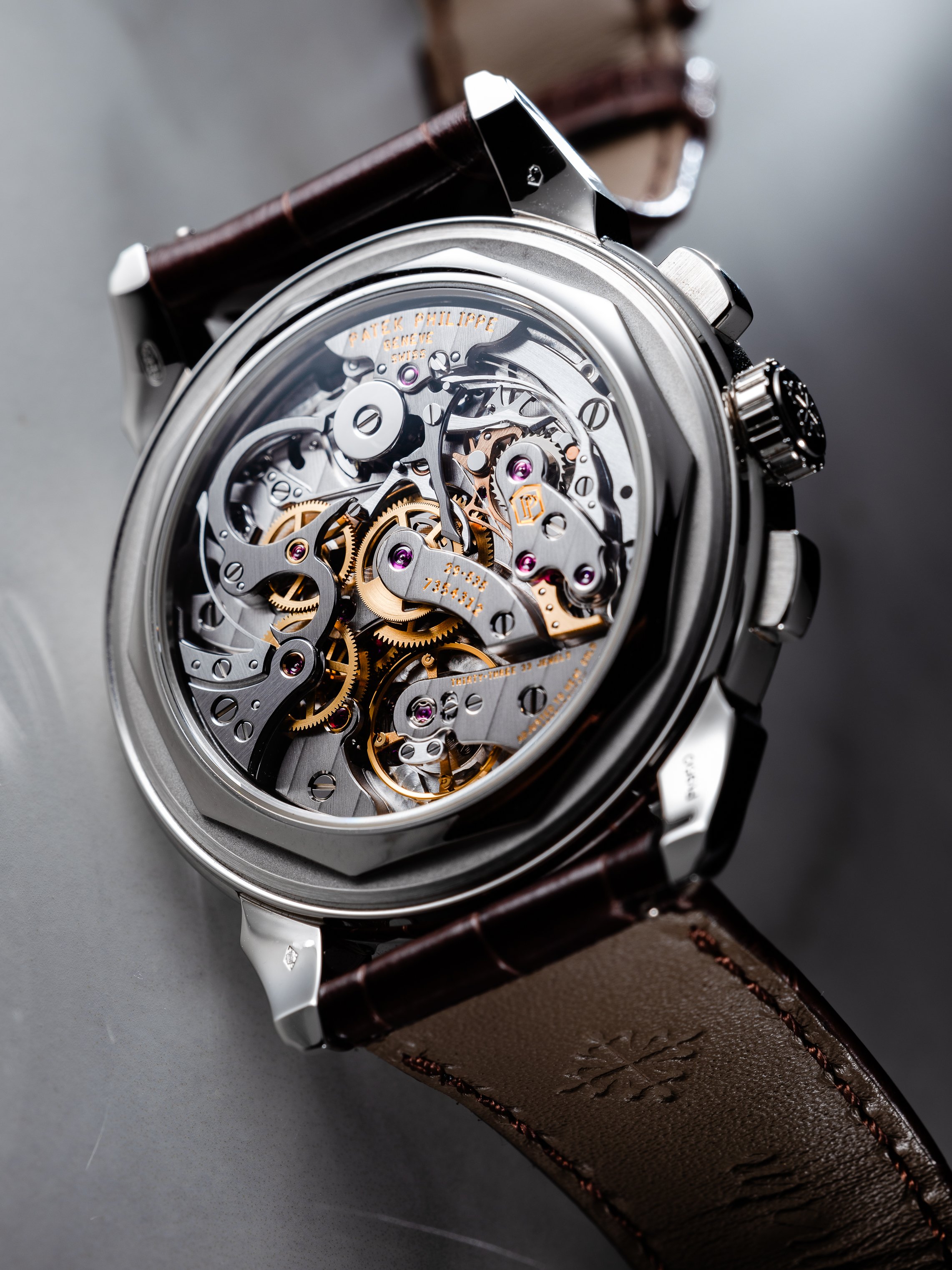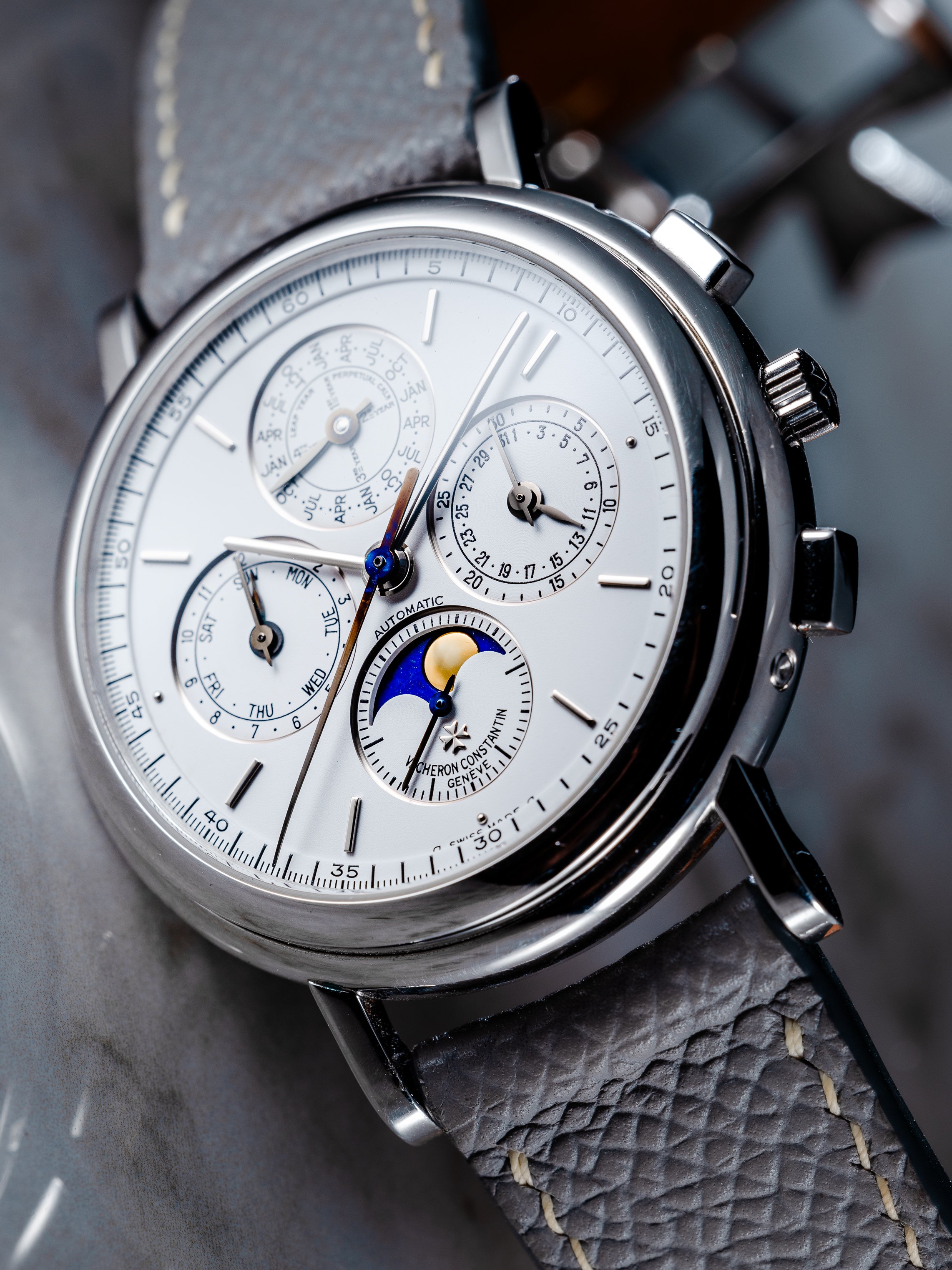Perpetual Calendar Chronograph
i’ve touched on chronos and then perpetuals, it’s time to combine them.
Cookies and Cream, peanut butter and jelly, pasta with ketchu… you probably know what I’m getting at. Some things in life are simply better together, like perpetual calendars and chronographs, Rachel and Ross. The chronograph’s elapsed minute or hour counters provide a perfect canvas for day, date, month and even leap year indicators to be integrated within.
ref. 5970R, watch belongs to my dear buddy @max
When discussing this combo of complications, we must start with the one and only:
Patek Philippe
A dear friend of mine co-wrote an article about Patek’s lineage of Perpetual Calendar chronographs (PCC). His name is Alp but you might know him as @langepedia. Check out that article here: Birth of a legend.
The TLDR of that comprehensive (#shameless) article covers Patek’s PCC from year 1941, when the seminal ref. 1518 was born. Then we touched on what I think is one of the best vintage model that Patek has ever made - ref. 2499 - produced from year 1950 to 1965. The article wrapped up with the neo-vintage ref. 3970 produced from 1985 to 2004. Ref. 3970 heralded a very important movement: Lemania Chronograph ref. 2310 or what Patek calls CH27-70. I know, a lot of digits. But if there’s one you must know, it’s what came after ref. 3970, my all-time favourite ref. 5970.
When you have forebears of such eminence, it’s tough being the following act.
We’re not just talking about watches here, but of a certain young (then) gentleman - Mr Thierry Stern. First, we have to talk about his father - Mr Phillipe Stern. Stern senior captained the ship through many storms, perhaps most notably the quartz crisis of 1980s. Besides callouses and battle scars, Stern Senior also had a very fine eye for aesthetics. Just look at the design of ref. 2499 and ref. 3970, and pay special attention to the dials.
all four series of ref. 2499 in one seating, pic credits: Phillips
father and son - ref. 2499(left) and 3970 (right), pic credits: Phillips
Immaculately balanced and immediately iconic, that’s how I would describe the dial layout of Patek’s perpetual chronographs. Ok, maybe not immediate but after 80+ years of using the same twin-aperture and tri-compax dial layout, this ‘look’ is just about as iconic as their Calatrava Cross.
The best way to sum up Stern Senior’s reign is? You guessed it - his most worn watch - ref. 3940.
ref. 3940J, pic credit: windvintage
Elegance par none. The seamless flow of calatrava lugs into the case, coupled with clean sans serif typography. You see this same horological grace flowing through the perpetual chronographs, from ref. 1518, ref. 2499 all the way until the last rendition of ref. 3970 in year 2004. The end of an era also means the start of a new one.
Year 2004 - ref. 5970
“Heroes aren’t born, they’re made”, was probably what Stern senior told Thierry Stern, then 34 years of age.
4-of-a-kind, white gold-rose gold-yellow gold-platinum, watches belong to my dear buddy @max
Instead of battling lions or climbing mountains through a blizzard, young Mr Thierry was given the task of creating Patek’s next perpetual chronograph.
Produced from year 2004 to 2011 for a mere seven years, ref. 5970 with its flared lugs, 40mm case diameter was something of an anomaly, especially when compared to its forebears. An estimated 2800+ examples were produced, and first out of the gate was 5970R - rose gold.
Ref. 5970R in rose gold, watch credit: my dear buddy, Max.
Next is my personal favourite of the lot. Like the beautiful rose gold above, this monotonous white gold variant was created in 2004. Calling it monotonous isn’t derogatory but factually speaking. After all, the only splash of colours are from the flame-blued steel hands that have since patinated. Staying on the monochromatic theme, I decided to pair mine with a light grey epsom strap from @delugs.
ref. 5970G
Up next is the rarest of them - yellow gold. A more exact word should’ve been scarce. After all, it was only produced for about a year or two from 2008 to 2009, with enthusiasts estimating around 300 pieces ever made before moving on to the final variant. Ref. 5970J has my favourite detail of them all - a matching yellow gold moon disc and stars!
ref. 5970J, with a gorgeous himalayan strap from @delugs, watch belong to my dear buddy @max
To celebrate the end of ref.5970, Patek released the only black dial variant with the most precious metal of them all - Platinum. See if you can spot two small differences. Clue, one’s on the dial, the other difference is on the case.
ref. 5970P, watch belongs to my dear buddy @max
Ans: There’s a diamond on the case at 6 o’clock, and the addition of 120 on tachymetre scale.
diamond at 6, a hidden signature of Patek’s Platinum watches
Aesthetic
At a large-sque size of 40mm, ref. 5970 doesn’t look a hair out of place even on a more casual outfit. Or maybe it’s because of my hairless wrist. When you do want to dress it up with a shirt, you’re simply returning to its natural dressy element. While I don’t do many wrist-shots, it’s the best way I can explain without going through a thousand words:
greater than a thousand words, ref. 5970G on @delugs navy saffiano
On the dial, you see the same twin-windows of day and month with a tri-compax subdial layout, a design concept used since the great-grandfather ref. 1518 in 1940s. The triump here for me, is perhaps quite contentious as well - the return of tachymetre.
The standard production range of ref. 3970 saw the omission of tachymetre, which isn’t a bad thing per se. After all, it’s a 36.5mm case with not much real estate on the dial. ’Standard’, because I know there are a few unique pieces of ref. 3970 that features a tachymetre, and some even with a pulsograph.
With an extra 3mm diameter space on the dial, the tachymetre is back in full scale, adding that touch of ‘sportyness’ to the watch. While I’m not diving underwater with ref. 5970, (with a change of strap) I think it’ll look pretty fine by the beach as well. The real diving I’ll be doing is into the movement.
Tech Talk - Cal. CH27-70 Q
What does Patek, Omega, Breguet and Vacheron Constantin have in common? They all used the same chronograph supplier - Lemania, specifically Calibre 2310. Check out how similar the base movements are from the image below.
Omega, Vacheron, Roger Dubuis, Patek, same same but different, pic credit: acollectedman
There are lots of literature about Lemania out there. Here, I quote my friend Alp in our previous article: The modifications carried out on the Lemania 2310 to transform it into the caliber CH 27-70 are extensive. According to Patek Philippe, over half of the provided components underwent modification or replacement. The agreement stipulated that Lemania would supply the fundamental gear train and components, while Patek Philippe would take charge of the rest.
So what are the aesthetic enhancements? Take a look yourself.
Calibre CH27-70 Q
Geneva stripes and a fine anglage on all the edges are some of the aesthetic enhancements that separate Patek from the more utilitarian Omega Cal. 321. If I had to pick my favourite change, it’ll have to be the chronograph lever.
Patek’s modified chronograph lever
What used to be a stubby little bridge, went through a Zaha Hadid remake, and is now a raptor-claw lever that engages the column wheel. Bravo, Patek, Bra-freaking-vo. After all that praise for ref. 5970 surely anything else that comes after would pale in comparison. Well, see for yourself.
2011 - Ref. 5270
After a short 7 year production, ref. 5970 made way for ref. 5270. Short, because by the time of this writing (year 2024), ref. 5270 is on its 13th year of production. Enduring design, or simply ran out of ideas? For me, this ref. 5270 wasn’t just another watch down the QP chrono tree of Patek Philippe. It was an announcement by Thierry Stern: I hath arrived.
Perpetual Calendar Chronograph Ref. 5270P
There’s no mucking about here, as we see distinct changes to the dial layout. Most obvious here are the two little apertures of day/night and leap year, shifted out from within sub-dials and onto the main dial. The chronograph sub-dials are also lowered from 3-9o’ clock to 4-8 o clock position.
The case was also upsized from to 41mm, (40mm for 5970) which sounds like a blasphemy when compared to a 36mm ref. 3970. Yet, Patek has a knack for making watch cases that wears very well, which I suspect has something to do with the lug-lug length and also height of the watch. In all, it’s a well-balanced case design that doesn’t exacerbate any wrist fatigue.
The major change isn’t on the dial or case though. With ref. 5270P, Patek bade adieu to their trusty Lemania-based chronograph movement which they’ve used for almost 30 years, and welcome a new era of in-house chronograph.
Cal. CH29-535 PS Q
CH29-535 was actually first created in 2009, launched with a ladies chronograph. A year later in 2010, it was launched with ref. 5170. Patek wasted no time at all. In quick succession and another year later, they added a revamped perpetual calendar module and launched it with ref. 5270.
Calibre CH29-535 PS
While I’ve made a bold claim that Patek is synonymous with Perpetual calendars, their prowess in chronographs is actually the one that’s undisputed. With their fully in-house manufactured CH29-535 PS, Patek really sealed their position as one of the best chronograph maker.
How much of an improvement is CH29 over the Lemania-based CH27? Well, a lot. New lever, minute cam and teeth profile are just some of the upgrades in terms of chronograph precision. The simplest way I can put describe this is likening it to upgrading your smartphone’s OS.
These are bug fixes and minor performance improvements that nobody cares about. Yet, they’re what makes the whole experience such a good one.
We’re only humans. Our eyes (and ears) are drawn to bells and whistles like the lollapalooza of Apple’s WWDC, or in the case of horology - Watches and Wonder. Don’t get me wrong. In the world of luxury, customer experience is everything. While it’s important to keep up with trends like salmon or green dials, a full rainbow gemset aquanaut is a little too trendy for me.
I’m not totally against bling though. My kinda flamboyance would be a full rose gold goutte(droplet) bracelet like this ref. 5270/1R.
Perpetual Calendar Chronograph ref. 5270/1R-001
Understated flamboyance may sound like an oxymoron, but that’s what Patek thrives at. Another manufacture that has toed that fine line is Vacheron Constantin.
Vacheron Constantin ref. 49005
For a maison with such a long history, it’s almost shocking for me to realise that their first perpetual chronograph was only released in 1992. And yes, it’s this. ref. 49005.
Ref. 49005 in platinum
Here is a watch much like Patek’s ref. 3970 we saw earlier. It’s classical in every styling: clean straight lugs, baton indices, square pushers. Perhaps the only thing ‘unorthodox’ here is its movement. We have a clue of that on the dial - AUTOMATIC.
The benefit of being slightly late to the game is that Vacheron had access to more modern movements like F.Piguet’s self-winding chronograph. I used to muse about how amazing ref. 49005 would’ve been if Vacheron had used Lemania’s manual wound ebauché Cal.2310. Not only would that be uninspiring, the convenience of a self-winding QP is something I come to appreciate after wearing one, and can never do without thereafter.
Malte Perpetual Chronograph
Say you’re one of those purists who prefer a N.A. machine, Vacheron heard your whining. Just to be clear, NA here refers to non-automatic, not naturally aspirated like you petrol-heads are thinking. In year 2000, VC launched the Malte collection and this perpetual chronograph resides at the pinnacle.
Malte Perpetual Calendar Chronograph, ref. 47112, pic credit: surefinance
One might have thought Andy Warhol snuck into Vacheron’s design department for this ref. 47112. Much like Patek’s transition from ref. 5970 to ref. 5270, Vacheron’s Malte QP chronograph saw a clear departure from the classical styling of ref. 49005 before.
First is the unmistakable and now iconic moonface 🌚 as a moonphase indicator. Next is a little window showing a singular digit of 1 to 4, indicating leap year. These two details are so quirky, but also very Vacheron.
When it comes to the movement, some might say it’s a copy of Patek’s ref. 3970/5970. After all, they both use the same base movement - Lemania Cal.2310.
Cal. 1141QP, based on Lemania chronograph, pic credit: watchcollector.co.uk
Copy? Hold your horses. Vacheron Constantin first used Lemania chronograph (ref. 47101) in 1989 around the same time Patek launched ref. 3970. Upon Richemont’s acquisition of Manufacture Roger Dubuis (who owned Lemania) in 2008, Vacheron also attained production benefits from being under the same group. As to whether in-house movements really matter, is a whole debate on its own.
What’s non-debatable is that both Patek’s CH27 and Vacheron’s Cal. 1141 is finished so well, they both achieved the immaculate standards of Geneval seal.
Traditionnelle Perpetual Chronograph
So you’re a traditionalist (pun unintended) lusting for a slice of historical movement ala Lemania, but finished with the exacting standards of modern technology, then you need to pay special attention to Vacheron’s ref. 5000T.
Ref. 5000T/000P, pic credit: Vacheron Constantin
First launched in 2016, there were two variants - platinum case with black dial, rose gold case with white dial. In 2022, a smoking hot salmon dial was released in platinum. All ref. 5000T come with the new and improved Cal. 1142QP, with an upgraded free-sprung balance wheel, higher frequency and even a Maltese cross column wheel cap.
Calibre 1142QP, spot the maltese cross cap, pic credit: Vacheron Constantin
While Malte was full-on quirky in terms of design, one thing it has over Traditionnelle is case size. At 43mm, Traditionnelle ref. 5000T is significantly larger than the 39mm Malte case. I’ll go so far to put myself on record here that if Vacheron makes a new QP chronograph at 39-40mm, I’m signing myself up for it immediately.
Note to VC: Just make sure you keep the iconic smile/frown ‘moonface’.
My Perspective
It’s no secret that I love Vacheron Constantin but when it comes to perpetual calendar chronographs, Patek has dominated that domain for long and rightfully so. They’ve found the most aesthetically harmonious layout that enhances legibility as well.
the most iconic perpetual calendar chronograph layout, ever.
There are some who may claim that Vacheron’s ref. 5000T took its inspiration from Patek, especially the twin-window of day-month. But is it, really? While it’s not a perpetual calendar, Vacheron has been using a twin-window display for their triple calendar since 1942.
Ref 4240, circa 1942, watch credit: @fifteenoclock
That being said, imitation is the best form of flattery and that’s great as long as Vacheron uses Cal.1142/Lemania-based movement for their new sub-40mm case perpetual chronograph. And while we are in the midst of dreaming, why not throw in a bunch of breguet numerals as well.
On that optimistic note, big thanks to my dear friend @max who has impeccable taste in watches, more importantly a touch of craziness to collect my favourite Patek perpetual chronograph in all four metals. It was a huge honour for me to shoot and witness them all in one seating. Here’s a parting shot that you never asked for:
Split-seconds Perpetual Chronograph ref. 5372P, watch belongs to my dear buddy @max
At 38.3mm x 12.93mm, this modern perpetual calendar rattrapante is proof that Patek Philippe is still the unassailable king of QP chronographs. As always, I hope you had a happy time reading.

























